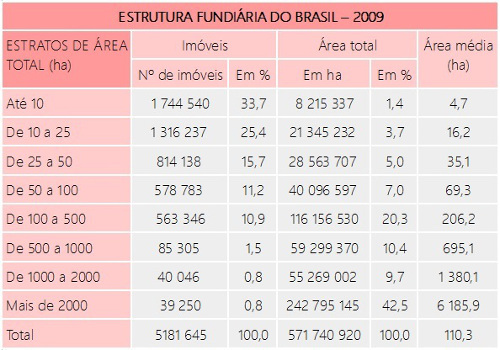One of the most debated internal political issues in the Brazilian territory is the issue of land concentration, that is, the undemocratic possession of most of the land in the rural area of the parents. Due to the intensive concentration of income, the establishment of export-oriented monocultures, in addition to a series of historical factors, the Brazilian field is highly concentrated in the hands of a few owners. Note the table below:

Table prepared by DIEESE regarding the agrarian structure in Brazil ¹
As you can see in the data from brazilian land structure, most of the area strata – 42.5% – is concentrated in 0.8% of properties, which have an average area of 6,185 hectares. On the other hand, 33% of the properties have an area equivalent to 1.4% of the occupied area strata, which is equivalent to an average area of only 4.7 hectares. Another 25.4% of the properties have an average area of 16.2 hectares and occupy 3.7% of the total area in Brazil destined for economic production in the countryside. This reveals that there is a large amount of land owned by a very small number of people.
However, it is a mistake to attribute the problem of Brazilian land concentration only to the policies of recent years. It is a historical process that has been perpetuated today and is often associated with question of the colonization of Brazil with the division of the area occupied by the Portuguese in Captaincies Hereditary. The sesmarias (law that distributed land among producers, forcing them to maintain some type of cultivation) are also mentioned, and, later, the Land Law of 1850, which added great value to the soil and made properties inaccessible to low-income populations. middle income.
On the other hand, rural social movements gathered in a more organized way from the 1950s onwards, although before there were also struggles for the democratization of possessions in rural areas. At that time, the so-called Peasant Leagues, which, until the beginning of the military dictatorship, gave the direction to the struggle for land in Brazil, including presenting a daring model of agrarian reform, endorsed by the then president João Goulart in 1963, which was deposed soon in followed by 1964 coup.
Do not stop now... There's more after the advertising ;)
During the military regime (1964-1984) the so-called Land Statute was drawn up to better regulate the land issue in the country. However, there are many criticisms directed at this law, which, according to some positions, may be considered a false attempt to promote agrarian reform, with the main purpose of making it difficult. bureaucratic.
Even later, with the end of the dictatorship and the consolidation of the National Plan for Agrarian Reform in 1985, the issue made little progress, mainly due to the strength of sectors ruralists, notably the UDR (Ruralist Democratic Union) which managed to overcome the rural social movements. These movements, at that time, had as their main representation the MST (Movement of Landless Rural Workers), which, through of occupations of rural latifundios that are almost always unproductive, it still tries to pressure the government for the complete execution of the reform. agaria.
please note that land reform it does not represent a simple distribution of land, but the feasibility for producers to produce on it, with tax incentives (such as some large producers receive today) and provision of technologies, methods and conditions of cultivation. It is also noteworthy that agrarian reform is not a consensus, with, for example, those ideologues who argue that its implementation would reduce the productivity of agribusiness and export goods from the parents. It is, after all, a controversial debate that has been dragging on for many years in Brazil without finding a proper consensus.
_________________________________
¹ Table data: DIEESE, Rural Environment Statistics 2010-2011. apud, MARTINS, D. et al. geography society and everyday life: Brazilian space. Volume 02, 3rd ed. São Paulo: educational scale, 2013. P. 109.
By Me. Rodolfo Alves Pena
